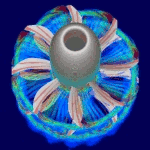 |
|
 |
Development of bypass-ratio
|
|
|
An increase of the BPR allows for a decrease in jet velocities and thus also a decrese
in the lost kinetic energy in the jet which is not used for propulsion.
This leads to a higher propulsive efficency of the engine. The loss in thrust due to the
lower velocities is compensated with a higher mass-flow of air through the engine.
This is the main reason why aero-engines with higher bypass-ratios are being developed,
as indicated by the crude trend-line in the diagram.
|
Influence of BPR on total airflow
|
|
|
To offset the loss in thrust due to the lower difference in jet-speed and aircraft speed
through the increase in BPR the mass of air flowing through the engine is larger.
|
Influence of BPR on specific thrust
|
|
|
The increase of the bypass ratio and the corresponding increase of airflow through the
engine leads to lower values for the specific thrust. Specific thrust is also an
indicator for the size of an engine for the thrust it produces. Smaller specific thrust
values mean larger engines.
|
Specific fuel consumption improvement
with increasing BPR
|
|
|
The reason to improve the propulsive efficency thorugh an increase in BPR is the gains
in specific fuel consumption (SFC) this brings. The amount of fuel necessary for a given
thrust is lower thanks to the improved turbofan-cycle at higher BPR.
|
Influence of BPR (bypass airflow) on fan pressure ratio
|
|
|
The fan pressure ratio needs to be lowered as BPR increases. As the FPR approaches a value
of about 1.4 the surge-margin decreases to a critical value. Therefore variable geometries
become necessary for the fan blades and/or the bypass-nozzle.
|
Development Turbine Inlet Temperatures
|
|
|
Improved materials (advanced metals as well as ceramics) and more effective cooling methods
have increased the permissable temperature for the first stages of the high-pressure turbine.
Still, there is a limit, ecspecially in light of the fact that an increase in Tt4
by 10 degrees Celsius without an improvement in materials or cooling halves the life of the
turbine components.
|
Influence of Tt4 on SFC
|
|
|
Larger Tt4 directly benefit the thermal efficency of the process, allowing for
lower specific fuel consumption.
|
Correlation between Tt4 and engine pressure ratio
|
|
|
The compressor pressure ratio is very much dependant on the turbine inlet temerature.
The optimal PR for the highest cycle efficency rises with Tt4.
Higher compressor pressure ratios require higher stage loading and/or more stages. The
latter adds weight and maintenance cost to the engine.
|
Devlopment of pressure ratio
|
|
|
Advances in aerodynamics thanks to design tools such as CFD as well as the improvements in
materials have enabled engineers to increase compressor pressure ratios. This is possible
through an increase in the amount of stages or preferably through the implementation of
highly-loaded airfoils. As a decrease in blade- and stage-count benefits engine weight,
aerodynamic performance, parts count and maintenance costs, the latter method is increasingly
important, as evidenced by the devlopment of new compressors with higher pressure ratios
yet fewer stages than their predecessors.
|
Influence of pressure ratio on SFC
|
|
|
The improvement that an increase in pressure ratio brings to the turbofan engines
thermodynamic cycle leads to a decrease in SFC.
|
Comments, corrections, additions and suggestions?
|
|
|
 |


